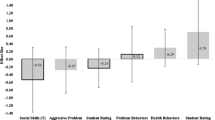Abstract
Teacher educators describe a developmental process they use for preparing pre-service teachers to support preschool-age children with and without disabilities in becoming socially competent. Social competence is crucial in developing the “whole” child and may actually foster other areas of development. Using qualitative data gathered from multiple classes over several years, the authors explain ways they guide future teachers in learning how to provide positive social environments. They describe their observations of changes in students’ beliefs about their roles and responsibilities, which appear to be influenced by the guided experiences they have provided. Activities implemented in early childhood and early childhood special education courses are shared, as well as student work samples that illustrate developing awareness and understanding.

Similar content being viewed by others
References
Copple, C., & Bredekamp, S. (2006). Basics of developmentally appropriate practice: An introduction for teachers of children 3 to 6. Washington, DC: National Association for the Education of Young Children.
Diamond, K. E., & Stacey, S. (2000). The other children at preschool: Experiences of typically developing children in inclusive preschools. In S. Sandall & M. Ostrosky (Eds.), Young Exceptional Children (YEC) Monograph Series No. 2. Natural environments and inclusion (pp. 59–68). Longmont, CO: Sopris West.
Division for Early Childhood (DEC). (2000). Code of ethics. In S. Sandall, M. E. McLean, & B. J. Smith (Eds.), DEC recommended practices in early intervention/early childhood special education (pp. 163–164). Longmont, CO: Sopris West.
Guralnick, M. J. (1999). The nature and meaning of social integration for young children with mild developmental delays in inclusive settings. Journal of Early Intervention, 22, 70–86.
Guralnick, M. J., & Neville, B. (1997). Designing early intervention programs to promote children’s social competence. In M. J. Guralnick (Ed.), The effectiveness of early intervention (pp. 579–610). Baltimore: Brookes.
Hurwitz, S. C. (2001). The teacher who would be Vivian. Young Children, 56(5), 89–91.
Joseph, G. E., & Strain, P. S. (2003). Comprehensive evidence-based social-emotional curricula for young children: An analysis of efficacious adoption potential. Topics in Early Childhood Special Education, 23, 66–76.
Kemple, K. M. (2004). Let’s be friends: Peer competence and social inclusion in early childhood programs. New York: Teachers College Press.
National Association for the Education of Young Children (NAEYC) (2002). Code of ethical conduct and statement of commitment: Guidelines for responsible behavior in early childhood education. Washington, DC: National Association for the Education of Young Children.
Odom, S. L., & Brown, W. H. (1993). Social interaction skills interventions for young children with disabilities in integrated settings. In: C. A. Peck, S. L. Odom, & D. D. Bricker (Eds.), Integrating young children with disabilities into community programs (pp. 39–64). Baltimore: Brookes.
Odom, S. L., McConnell, S. R., & Chandler, L. K. (1993). Acceptability and feasibility of classroom-based social interaction interventions for young children with disabilities. Teaching Exceptional Children, 60, 226–236.
Odom, S. L., & McEvoy, M. A. (1988). Integration of young children with handicaps and normally developing children. In S. L. Odom, & M. B. Karnes, (Eds.), Early intervention for infants and children with handicaps. Am empirical base(pp. 241–267). Baltimore: Brookes.
Paley, V. G. (1992). You can’t say you can’t play. Cambridge, MA: Harvard University Press.
Parlakian, R. (2003). Before the ABCs: Promoting school readiness in infants and toddlers. Washington, DC: Zero to Three.
Stoneman, Z. (1993). The effects of attitude on preschool integration. In: C. A. Peck, S. L. Odom, & D. D. Bricker, (Eds.), Integrating young children with disabilities into community programs (pp. 223–248). Baltimore: Brookes.
Author information
Authors and Affiliations
Corresponding author
Rights and permissions
About this article
Cite this article
Appl, D.J., Spenciner, L.J. What do Pre-Service Teachers See as Their Roles in Promoting Positive Social Environments? “I see Myself as a Facilitator of Acceptance”. Early Childhood Educ J 35, 445–450 (2008). https://doi.org/10.1007/s10643-007-0188-1
Received:
Accepted:
Published:
Issue Date:
DOI: https://doi.org/10.1007/s10643-007-0188-1




